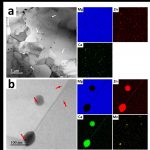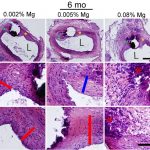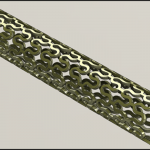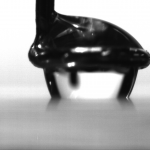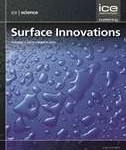We have published a new article entitled “Tailoring the mechanical and degradation performances of Mg-2.0Zn-0.5Ca-0.4Mn alloy through microstructure design” in the JOM journal A novel Mg-2.0Zn-0.5Ca-0.4Mn alloy was formulated and processed through melt spinning and hot extrusion to enhance the mechanical and degradation properties. Microstructural characterization on the rapidly solidified alloy ribbons consolidated by extrusion (RS+Ex) revealed a fine and fully recrystallized microstructure with an average size of 4µm. The conventionally extruded (Ex) alloy consisted of several course second phase strips as coarse as 100 µm, while the RS+Ex was devoid of any second phases larger than 100 nm. RS+Ex processing resulted in significantly randomized texture where the majority of the basal planes were tilted toward transverse and extrusion directions. Such a weak texture resulted in higher activity of basal planes and thereby, considerably improved the fracture elongation from 4% to 19 %, while keeping relatively high tensile strength of 294 MPa. In addition to high strength and ductility due to the reduced activity of deformation twining during the compression, the RS+Ex alloy showed lower yielding asymmetric ratio than that measured for Ex alloy (1.25 vs 1.61). Electrochemical measurements and immersion tests indicate that applying RS+Ex remarkably reduces the corrosion rate from 2.49 to 0.37 mm/year due to recrystallization completion and suppression of coarse second phase formation.
Intimal Hyperplasia for Zn Implants
Biodegradable arterial implants based on zinc have been found to suppress neointimal hyperplasia, suggesting that biodegradable materials containing zinc may be used to construct vascular implants with a reduced rate of restenosis. However, the molecular mechanism has remained unclear. In this new report from Prof. Jeremy Goldman laboratories entitled Zn2+-Dependent Suppression of Vascular Smooth Muscle Intimal Hyperplasia from Biodegradable Zinc Implants, published in Materials Science and Engineering C, we show that zinc-containing materials can be used to prevent neointimal formation when implanted into the rat aorta. Indeed, neointimal cells were significantly more TUNEL positive and alpha-actin negative at the interface of biodegradable zinc vs. biostable platinum implants, in association with greater caspase-3 activity. Although zinc stimulated extensive neointimal smooth muscle cell (SMC) death, macrophage and proinflammatory markers CD68 and iNOS were not increased in neointimal tissue relative to biostable platinum control implants. Using arterial explants, ionic zinc was confirmed to promote SMC apoptosis by activating the caspase apoptotic signaling pathway. These observations suggest that zinc-containing materials can be used to construct vascular implants such as stents with reduced neointimal hyperplasia.
Flotation of Magnesite
Our visiting scholar from the Northeastern University in Shenyang published a new paper entitled Effect of Nano-sized Roughness on the Flotation of Magnesite Particles and Particle-Bubble Interactions in the Minerals Engineering journal. In this study, magnesite was ground in stainless-steel disc and ceramic ball mills to produce flotation feed material of different surface nano-roughness, which was quantified using atomic force microscopy (AFM). The effect of surface roughness on the floatability of magnesite particles was carried out by a micro-flotation kinetic test using an XFG flotation machine. The flotation results demonstrated both higher flotation recovery and larger flotation rate constant for particles having larger nano-asperities of rough particle surface. Additionally, the difference in cumulative flotation recovery between magnesite particles with different nano-roughness characteristics systematically decreased with increasing collector (sodium oleate) concentration from 25 to 150 mg/L. Contrarily, a difference in the value of flotation kinetics constant for particles with larger and smaller asperities remained at a level of 0.2-0.3 min-1 for the entire range of collector concentration. The interaction energy between bubbles and rough magnesite particles with different nano-roughness was estimated using an extended DLVO (Derjaguin–Landau–Verwey–Overbeek) theory. The theoretical interaction energy points to lowering energy barrier when the magnesite particles are covered with 12 nm asperities as compared to 2 nm asperities. It is therefore hypothesized that the energy barrier is a primary cause for differences in flotation performance of particles decorated with nano-asperities of different dimensions.
Effect of Proteins on Zn Corrosion
Understanding the surface interactions and reactivity of Zn-based biomaterials with constituents of physiological fluids such as proteins and ions is essential for an accurate evaluation of biomaterial corrosion initiation and progression. In our new contribution entitled Albumins Inhibit the Corrosion of Absorbable Zn Alloys at Initial Stages of Degradation published in Surface Innovations, the effect of the albumin proteins addition on the corrosion behavior of Zn and its binary (Zn-4Ag) and ternary (Zn-4Ag-0.6Mn) alloys is discussed. The corrosion behavior of Zn-based materials was studied using potentiodynamic polarization, electrochemical impedance spectroscopy, immersion tests and X-ray photoelectron spectroscopy. It was found that the addition of albumins largely affects the chemical composition, morphology and compactness of the protective films formed on biomaterials. A shift of the corrosion regime from localized to more general was observed in the protein-containing electrolytes. The proteins acted as corrosion inhibitors, reducing the corrosion current density and promoting passivation of the metallic surfaces. The increase in the corrosion resistance of the binary and ternary alloys is attributed to a selective Zn ion leaching that leaves the metal surface enriched with electrochemically more stable alloying elements.
Liquid Adhesion to Concentric Pattern
Advances made in fabrication of patterned surfaces with well-defined dimensions of topographic features and their lateral dissemination drive the progress in interpretation of liquid spreading, adhesion and retreat on engineered solid surfaces. Despite extensive studies on liquid droplet spreading and adhesion on textured surfaces in recent years, conformation of the three-phase contact line and its effect on macroscopic contact angle and droplet adhesion remain in a focus of intensive debate. In our new paper entitled Contact Line and Adhesion Force of Droplets on Concentric Ring-Textured Hydrophobic Surfaces published in Langmuir, we investigate the effect of surface topography on adhesion force of Cassie-Baxter-state droplets on concentric ring-textured hydrophobic surfaces having rings with lateral dimensions of 5, 10, and 45 μm and separated by 5, 6, and 7 μm trenches, with fixed depth of 15 μm, respectively. Unlike mostly-tested surfaces textured with straight ridges, pores, and pillars, where the droplet base contact line is anisotropic and its conformation varies along the apparent boundary, concentric rings are symmetrical and reinforce the microscopic contact line to align to a circular one that reflects the shape of the pattern. In this study, adhesion forces were calculated based on surface tension and Laplace pressure forces and compared with the experimental forces for both water and ethylene glycol droplets having a varying contact diameter on the concentric ring-pattern at the point of maximum adhesion force. Results show that the microscopic contact line of the liquid retains its circular shape controlled by circular rings of the pattern, irrespectively of the droplet base diameter larger than 0.8 mm, and there is a good agreement between the experimental and calculated adhesion forces.
SI Volume 8 Issue 3
We would like to share with you the content of the third issue of 2020 of Surface Innovations. This issue offers eight quality original papers on a broad variety of topics. Hope many of you will find something interesting among these papers.
MSGC Scholarships
Congratulations to Emily Tom and Torri Nizzi for winning the Michigan Space Grant Consortium (MSGC) fellowships in graduate and undergraduate, respectively, categories.
Water Adhesion to Methylated Glass
Measurements of the spreading and capillary forces for liquids deposited on solid surfaces of varying surface chemistry and topography are a prerequisite to better understanding and quantification of the wetting mechanisms. In this study, glass slide surfaces were modified with trimethylchlorosilane to fabricate surfaces of varying hydrophobicity. Then, the forces of spreading and adhesion were measured between water droplets and glass surfaces using a high-sensitivity microelectronic balance. Integrated with a digital camera, the experimental set-up recorded forces and water droplet deformations during water droplet attachment, spreading, compression and retraction processes. It was confirmed that the spreading force increases with decreasing advancing contact angle for methylated glass, following a similar correlation as observed for smooth and rough polymers. However, the spreading force values for methylated glass were a few times lower than reported for polymers in spite of a similar roughness characteristic. It was also confirmed that the maximum adhesion force between water droplet and methylated glass increases with decreasing value of the most stable contact angle, a correlation that is similar to that reported for smooth polymers. The paper entitled Spreading and adhesion forces for water droplets on methylated glass surfaces was published in Colloids and Surfaces A.
Visit of Former Student
We really enjoyed the three-days visit by Sara Schellbach, our former undergraduate researcher, who graduated from MSE program in 2016. She currently works for GM, and pursues her MS degree at Wayne State University. Sara came with her brother who will join Michigan Tech in the fall semester. This was a great opportunity to gather entire team together for a pizza and beer at the Ambassador restaurant.
When Sara worked with us, she explored wettability of natural fibers, using a novel technique developed in our laboratory. Her paper entitled A novel method of contact angle measurements on natural fibers was published in Materials Letters. This paper has been well received, especially researchers who explore the use of natural fibers.
Stable Zn Alloys for Stenting
Zn-based alloys have been recognized as highly promising bioabsorbable materials for cardiovascular stents, due to their biocompatibility and, more importantly, favorable corrosion rates as compared to Mg alloys. However, both low tensile strength and intrinsic mechanical instability arisen from strong strain rate sensitivity and strain softening behavior make development of Zn alloys challenging for vascular scaffolding applications. In our new study published in Acta Biomaterialia and entitled Towards revealing key factors in mechanical instability of bioabsorbable Zn-based alloys for intended vascular stenting, which was carried out in collaboration with the researchers from the University of Sheffield and University of Oxford, we developed, processed and characterized binary Zn-4.0Ag and ternary Zn-4.0Ag-Mn alloys. An experimental methodology was designed by cold working followed by a thermal treatment on extruded alloys, through which the effects of the grain size and precipitates could be thoroughly investigated. Microstructural observations revealed a significant grain refinement during the cold wire drawing, leading to an equiaxed ultrafine grain (UFG) structure with an average size of 670 nm and 240 nm for the Zn-4.0Ag and Zn-4.0Ag-0.6Mn alloys, respectively. Mn showed a powerful grain refining effect as it promoted the dynamic recrystallization and hindered the growth of the UFG grains during the drawing process. In addition, cold working resulted in dynamic precipitation of markedly fine AgZn3 particles, distributing throughout the Zn matrix. Such strain-induced precipitates triggered mechanical degradation through an activation of Zn/AgZn3 boundary sliding, exhibiting maximum elongation of 430% and 203 % at the strain rate of 3.3 × 10−3 s−1 for Zn-4.0Ag and Zn-4.0Ag-0.6Mn, respectively. The observed precipitation softening phenomenon caused strong strain rate sensitivity and distinct strain softening behavior in the cold drawn alloys. Short-time annealing significantly mitigated the mechanical instability by reducing the AgZn3 volume fraction and thus, decreased the contribution of Zn/AgZn3 boundary sliding. The ternary alloy wire showed superior microstructural stability as compared to its Mn-free counterpart due to the pinning effect of nanosized Mn particles on the grain boundaries, restricting the grain coarsening. The corrosion results revealed that the microstructural manipulation strongly influenced the corrosion behavior of the Zn alloys so that the cold drawn wires exhibited intensive pitting corrosion. However, a shift of the corrosion regime from localized to a more uniform was observed after applying the heat treatment, mainly due to the dissolution of AgZn3 precipitates.
